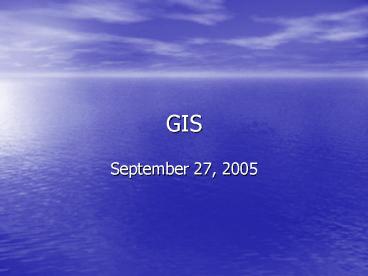GIS PowerPoint PPT Presentation
1 / 29
Title: GIS
1
GIS
- September 27, 2005
2
Announcements
- Next lecture is on October 18th (read chapters 9
and 10)
3
Uncertainty
4
- Error (differences between observers or between
measuring instruments) - Accuracy (difference between reality and our
representation of reality) - Precision (the repeatability of measurements)
- Quality (attribute accuracy, positional accuracy,
logical consistency, completelness, and lineage)
5
(No Transcript)
6
U1 Conception
- Spatial uncertainty
- Do Natural geographic units exist?
- Scales for bivariate/multivariate analyses?
- Discrete objects more reliant on natural units
- Vagueness (in boundaries, membership)
- Statistical, cartographic, cognitive
- Ambiguity
- Different labels by different national or
cultural groups, language (GIS is not
value-neutral!!)
7
Indicators
- Direct - clear correspondence with mapped
phenomenon) - Indirect (or proxy) best available measure
- Selection of indicators is subjective
- Differences in definitions are a major impediment
to integration of geographic data over wide areas
8
Fuzzy Approaches to Uncertainty
- In fuzzy set theory, it is possible to have
partial membership in a set - membership can vary, e.g. from 0 to 1
- this adds a third option to classification yes,
no, and maybe - Fuzzy approaches have been applied to the mapping
of soils, vegetation cover, land use, and
vulnerability
9
(No Transcript)
10
Scale Geographic Individuals
- Regions
- Uniformity (internal homogeneity)
- Functional zones (boundaries as breakpoints)
- Relationships typically grow stronger when based
on larger geographic units
11
Scale and Spatial Autocorrelation
- No. of geographic Correlation
- areas
- 48 .2189
- 24 .2963
- 12 .5757
- 6 .7649
- 3 .9902
12
(No Transcript)
13
U2 Measurement/representation
- Representational models filter reality
differently - Vector (requires a priori conceptualization of
geographic features as discrete objects) - Raster (boundaries seldom resemble natural
features, but convenient and efficient)
14
0.9 1.0
0.5 0.9
0.1 0.5
0.0 0.1
15
Other issues
- Measurements only accurate to a limited extent
- Continuous scales are in practice discrete
- Discrete isopleth/choropleth map display
- Choropleth mapping in multivariate cases
- Box 4.3 explains the difference!
16
Spatially Intensive versus Extensive Variables
- Choropleth maps use values describing properties
of non-overlapping areas (municipalities, states,
countries) - Extensive variables values true for the entire
area are the same color E.g. Total population - Intensive variables values could potentially be
true for every part of the area (an average).
E.g. Population density.
17
(No Transcript)
18
Measurement Error
- Digitizing errors
- Automated solutions
- Conflation of adjacent map sheets
19
(No Transcript)
20
(No Transcript)
21
Data Integration and Lineage
- Concatenation
- E.g. polygon overlay
- Conflation
- E.g. rubber sheeting
- Persistent error indicates shared lineage
- Errors tend to exhibit strong positive spatial
autocorrelation
22
(No Transcript)
23
(No Transcript)
24
(No Transcript)
25
U3 Analysis
- Can good spatial analysis develop on uncertain
foundations? - Can rarely correct source
- More usually tackle operation (internal
validation) - Conflation/concatenation allows external
validation of zonal averaging effects - Error propagation measures impacts of uncertainty
in data on the results
26
Ecological Fallacy
- Inappropriate inference from aggregate data about
the characteristics of individuals - Fundamental difference between geography and
other scientific disciplines is that definitions
of objects of study is almost always ambiguous.
27
Modifiable Areal Unit Problem (MAUP)
- Scale aggregation MAUP
- can be investigated through simulation of large
numbers of alternative zoning schemes - Apparent spatial distributions which are
unrepresentative of the scale and configuration
of real-world geographic phenomena (example
urban density)
28
Summary
- Uncertainty is more than error
- Richer representations can create uncertainty!
- Need for a priori understanding of data and
sensitivity analysis - Spatial analysis is often context-sensitive (you
need to know your data and place!)
29
Living with Uncertainty
- Acknowledge that uncertainty is inevitable
- Data should never be taken as truth (assess
whether it is suitable) - Uncertainties in outputs may exceed uncertainties
in inputs because many GIS processes are highly
non-linear - Rely on multiple sources of data
- Be honest and informative in reporting the
results of GIS analysis.

